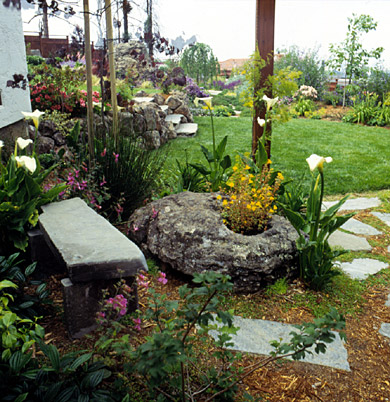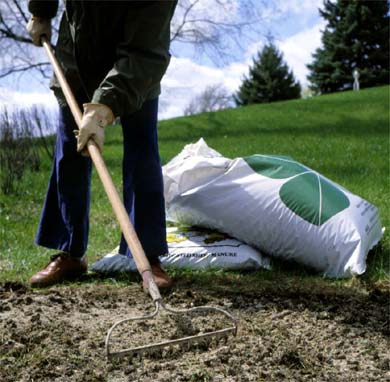





 With a little attention, you can keep your landscape weed-free.
With a little attention, you can keep your landscape weed-free.
The battle lines are drawn, and it doesn't look good. Your favorite cosmos are surrounded by an angry troop of chickweed that keeps getting reinforcements. Your corn is short and malnourished, unable to defend itself against an invasion of velvetleaf. Your pretty garden path is being infiltrated through every crevice by knotweed. And you can't even bear to look at your once-lush fescue lawn, which is being ravaged by a regiment of crabgrass.
All gardeners know what it's like to have their yards invaded by unwelcome plants. Although there's no easy way to banish weeds, there are a few techniques you can use to reclaim your turf -- at the least, you can limit hostile takeovers.
continue reading below1. Be a mulching maniac. Mulch acts as a suffocating blanket by preventing light from reaching weed seeds. At the same time, it holds moisture for your plants and provides nutrients for your soil as it decomposes. Apply coarse mulch, such as bark or wood chips, directly onto soil. Leaves, grass clippings, or straw work better as a weed deterrent with a separating layer of newspaper, cardboard, or fabric between them and the soil.
2. Water those weeds. Pulling weeds is easier and more efficient when the soil is moist. You are more likely to get the whole root system, and your yanking won't disturb surrounding plants as much either. No rain? Turn on the sprinkler or even water individual weeds, leave for a few hours, then get your hands dirty. (Just ignore the strange looks from your neighbors as you water your weeds.)
3. Cut weeds down in their prime. Weeds love open soil. But if you till or cultivate, then wait to plant, you can outmaneuver the weeds. Till the ground at least twice before you plant. Your first digging will bring dormant weed seeds to the surface where they can germinate. Watch and wait for a few weeks until they begin to grow. Then slice up the weeds again with a tiller or a hoe, only don't dig as deep. Now it should be safe to put precious plants into the soil.
4. Pass the salt. Try sweeping rock salt into crevices between paths. Although more harsh, borax also works well. Be sure to wear rubber gloves with the latter material. You might need to apply a few doses, but be aware of any surrounding plants because both products kill the good plants along with the bad.
5. Lay down the law. Try using landscape fabric as a weed controller. Landscape fabric is usually made of a nonwoven, porous polypropylene fabric, which enables air, water, and nutrients to reach the soil but keeps weed seeds in a dark, cool environment where they can't germinate. You lay down the fabric, cut a hole where your plants are positioned or will be planted, then cover the fabric with a 2- to 4-inch layer of mulch or gravel. However, landscape fabric doesn't work well on steep slopes or windy sites, where the mulch often slides off or is blown away, exposing the fabric. Never use plastic, as it prevents moisture and air from reaching your plants' roots.
6. Boil them alive. If you have pesky weeds in a spot with no nearby grass or valuable plants, boil water and pour it over the unsuspecting weeds. To control the stream of boiling water and to save surrounding plants and your toes from a scalding, use a teakettle.
7. To compost or not to compost. After you've labored to rid your garden of weeds, be careful that you don't throw weeds onto the compost heap where they can drop seed and infect your entire yard. When you pull or till young weeds, leave them where you chop them and let the sun dry them out, then use them as mulch. Throw mature weeds on a hot compost pile where they should cook at 200 degrees or higher for several weeks to ensure the seeds are killed.
Learn how to identify weeds.
 Proper preparation when setting up
your garden can help prevent weeds.
Proper preparation when setting up
your garden can help prevent weeds.
8. Cover your ground. Cultivate plants close together or grow winter groundcover in areas that typically suffer from weed invasion. A thick mass of plants not only is attractive but also shelters the soil from direct sunlight, making it more difficult for weed seeds to prosper.
9. Old-fashioned elbow grease. Weed every couple of weeks throughout the growing season in order to stay in control of the weed situation. If you're going to get down and dirty, use a comfortable knee cushion or try pads to lessen the impact of weeding on your body. You can also try an upright tool such as the Weed Hound, which prevents excessive bending or body strain.
10. Solar-powered soil. Solarization uses heat to disinfect your soil. If you have a large planting bed or area of lawn that you want to reseed, till the area to clear all vegetation. Then water the area until it is saturated. Wait 24 hours, then cover with clear 3- to 6-mil plastic sheeting. Bury the edges of the sheeting to seal it. Let the soil cook for four to six weeks, then remove the plastic. If any weeds appear, till them lightly without disturbing the soil. Wait a few days for the soil to cool, then start planting. This method helps get rid of many soil-borne diseases as well.
11. Kiss my grits. You can try a natural weed control such as WOW! (WithOut Weeds), which is made from a byproduct of corn. It acts as a preemergent best applied during the spring, killing weeds before they germinate. A second application at the end of the growing season helps kill weeds that sprout late in the summer and go to seed in the fall. Its nontoxic formula is safe, and it even releases nitrogen into your soil.
12. I.D. your weeds. If you can identify the sprouting menaces in your yard, you can control their reseeding habits better. Annual weeds complete their growing cycle from seed to plant in a few months, then die. Unfortunately, they can leave behind thousands of babies if they go to seed, so always try to remove annuals before they drop seeds. Perennial weeds usually live for at least three years and are more difficult to banish, so at first sighting remove them immediately.
13. Time is tight. If the weeds are starting to grow, but you don't have the time or energy to pull them up at the moment, suffocate the weeds by covering them with a block of wood or piece of plastic. Better yet, use a few large decorative stones, a work of art, or a birdbath. At least you'll stop the weeds from spreading so you can tackle them when you have time.
14. Off with their heads. To stop weeds from spreading, pluck off their flower heads before they drop seed. This technique can be especially helpful with annual weeds, which love to provide generation after generation of weeds.
15. Don't go too low. To help discourage weed germination in your lawn, avoid scalping with your mower. A buzzed lawn not only kills the grass in that spot, it allows light to reach the weed seeds and gives them the opportunity to sprout and run amok. Raising your mower blade also helps promote extra root growth in your lawn, making it harder for weeds to get a foothold.
Copyright © www.100flowers.win Botanic Garden All Rights Reserved